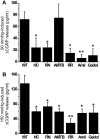Differential Contribution of TRPA1, TRPV4 and TRPM8 to Colonic Nociception in Mice
- PMID: 26207981
- PMCID: PMC4514604
- DOI: 10.1371/journal.pone.0128242
Differential Contribution of TRPA1, TRPV4 and TRPM8 to Colonic Nociception in Mice
Abstract
Background: Various transient receptor potential (TRP) channels in sensory neurons contribute to the transduction of mechanical stimuli in the colon. Recently, even the cold-sensing menthol receptor TRPM(melastatin)8 was suggested to be involved in murine colonic mechano-nociception.
Methods: To analyze the roles of TRPM8, TRPA1 and TRPV4 in distension-induced colonic nociception and pain, TRP-deficient mice and selective pharmacological blockers in wild-type mice (WT) were used. Visceromotor responses (VMR) to colorectal distension (CRD) in vivo were recorded and distension/pressure-induced CGRP release from the isolated murine colon ex vivo was measured by EIA.
Results: Distension-induced colonic CGRP release was markedly reduced in TRPA1-/- and TRPV4-/- mice at 90/150 mmHg compared to WT. In TRPM8-deficient mice the reduction was only distinct at 150 mmHg. Exposure to selective pharmacological antagonists (HC030031, 100 μM; RN1734, 10 μM; AMTB, 10 μM) showed corresponding effects. The unselective TRP blocker ruthenium red (RR, 10 μM) was as efficient in inhibiting distension-induced CGRP release as the unselective antagonists of mechanogated DEG/ENaC (amiloride, 100 μM) and stretch-activated channels (gadolinium, 50 μM). VMR to CRD revealed prominent deficits over the whole pressure range (up to 90 mmHg) in TRPA1-/- and TRPV4-/- but not TRPM8-/- mice; the drug effects of the TRP antagonists were again highly consistent with the results from mice lacking the respective TRP receptor gene.
Conclusions: TRPA1 and TRPV4 mediate colonic distension pain and CGRP release and appear to govern a wide and congruent dynamic range of distensions. The role of TRPM8 seems to be confined to signaling extreme noxious distension, at least in the healthy colon.
Conflict of interest statement
Figures






Similar articles
-
TRPA1 and TRPV4 activation in human odontoblasts stimulates ATP release.J Dent Res. 2014 Sep;93(9):911-7. doi: 10.1177/0022034514544507. Epub 2014 Jul 25. J Dent Res. 2014. PMID: 25062738 Free PMC article.
-
Antinociceptive activity of transient receptor potential channel TRPV1, TRPA1, and TRPM8 antagonists in neurogenic and neuropathic pain models in mice.J Zhejiang Univ Sci B. 2015 Mar;16(3):167-78. doi: 10.1631/jzus.B1400189. J Zhejiang Univ Sci B. 2015. PMID: 25743118 Free PMC article.
-
TRPA1 and TRPV4 mediate paclitaxel-induced peripheral neuropathy in mice via a glutathione-sensitive mechanism.Pflugers Arch. 2012 Apr;463(4):561-9. doi: 10.1007/s00424-011-1071-x. Epub 2012 Jan 19. Pflugers Arch. 2012. PMID: 22258694
-
TRP Channels in Nociception and Pathological Pain.Adv Exp Med Biol. 2018;1099:13-27. doi: 10.1007/978-981-13-1756-9_2. Adv Exp Med Biol. 2018. PMID: 30306511 Review.
-
TRP channels and analgesia.Life Sci. 2013 Mar 19;92(8-9):415-24. doi: 10.1016/j.lfs.2012.08.010. Epub 2012 Aug 14. Life Sci. 2013. PMID: 22910182 Free PMC article. Review.
Cited by
-
Optogenetic Activation of Colon Epithelium of the Mouse Produces High-Frequency Bursting in Extrinsic Colon Afferents and Engages Visceromotor Responses.J Neurosci. 2018 Jun 20;38(25):5788-5798. doi: 10.1523/JNEUROSCI.0837-18.2018. Epub 2018 May 22. J Neurosci. 2018. PMID: 29789376 Free PMC article.
-
Cardamonin, a Novel Antagonist of hTRPA1 Cation Channel, Reveals Therapeutic Mechanism of Pathological Pain.Molecules. 2016 Aug 29;21(9):1145. doi: 10.3390/molecules21091145. Molecules. 2016. PMID: 27589700 Free PMC article.
-
Genome-Wide Characterization and Gene Expression Analysis of TRP Channel Superfamily Genes in the Migratory Locust, Locusta migratoria.Genes (Basel). 2023 Jul 11;14(7):1427. doi: 10.3390/genes14071427. Genes (Basel). 2023. PMID: 37510331 Free PMC article.
-
Transient receptor potential melastatin 8 ion channel in macrophages modulates colitis through a balance-shift in TNF-alpha and interleukin-10 production.Mucosal Immunol. 2016 Nov;9(6):1500-1513. doi: 10.1038/mi.2016.16. Epub 2016 Mar 16. Mucosal Immunol. 2016. PMID: 26982596
-
TRP channel functions in the gastrointestinal tract.Semin Immunopathol. 2016 May;38(3):385-96. doi: 10.1007/s00281-015-0528-y. Epub 2015 Oct 12. Semin Immunopathol. 2016. PMID: 26459157 Review.
References
Publication types
MeSH terms
Substances
LinkOut - more resources
Full Text Sources
Other Literature Sources
Molecular Biology Databases
Research Materials

